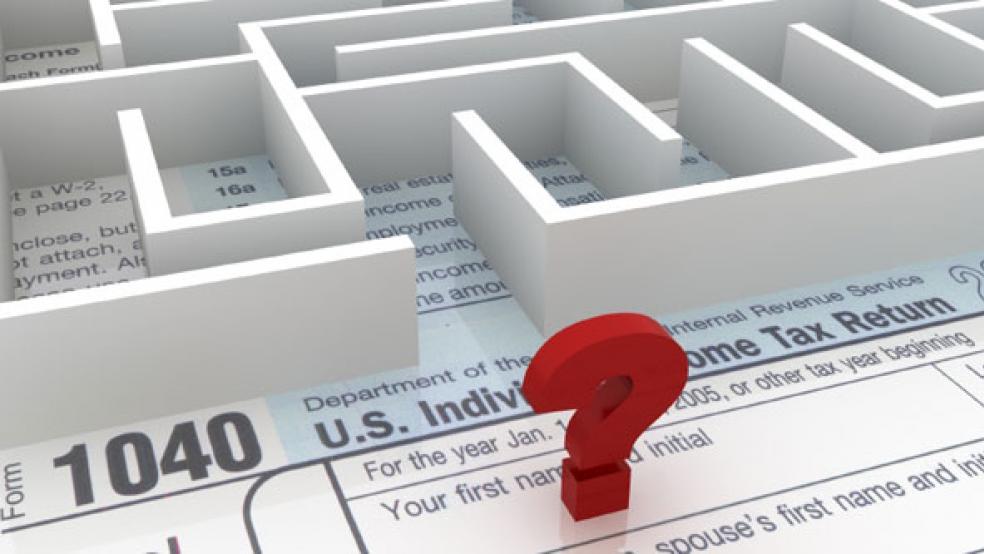The conservative-leaning Tax Foundation issued a press release Monday touting some “good news for tax reformers”: An analysis by experts at the foundation found that a plan to dramatically simplify both the individual and corporate tax codes would cost about $1.5 trillion less than projected.
That means that lawmakers wouldn’t have to come up with quite as much money from eliminating loopholes and tax breaks as they seek to avoid raising the deficit.

As is often the case, the good news comes with plenty of caveats, though.
The new analysis centers on a bipartisan tax reform plan being pushed by House Ways and Means Committee Chairman Dave Camp (R-MI) and Senate Finance Committee Chairman Max Baucus (D-MT). The two lawmakers have been working to drum up support for reforms that would replace the nation’s current tax system with just two individual income tax brackets, at 10 percent and 25 percent, and would lower the top corporate tax rate from 35 percent to 25 percent.
RELATED: WHAT BAUCUS AND CAMP ARE GETTING WRONG ON TAX REFORM
Their reform hinges on the promise to keep the changes “revenue neutral,” so that slashing rates doesn’t also slash the amount the government collects or add to the deficit. That means reformers would need to agree to close loopholes and eliminate tax breaks worth more than $5 trillion over 10 years, based on so-called “static” estimates from Congress’s Joint Committee on Taxation (JCT).
It’s a daunting task. The Tax Foundation report notes that just cutting the corporate tax rate would cost an average of nearly $130 billion a year. “Making up this amount would require eliminating nearly everything currently listed as a corporate tax preference in the tax code,” the new report says. And if the math on the corporate side is “nearly impossible,” as the report suggests, finding the political will to cut the mortgage interest deduction or other breaks popular with voters may be even more difficult.
“Depending on what one considers a loophole, there simply may not be enough inappropriate or detrimental provisions in the tax code to eliminate in order to offset the amount of static revenue loss for the Treasury,” the Tax Foundation economists write.
Here’s where the good news comes in: The foundation says the $5 trillion target is way too high because the standard static modeling used by the JCT fails to factor in the economic growth and increased wages that would be spurred by lowering tax rates. Using a “dynamic” analysis, the Tax Foundation says the costs of the lower rates would be about 30 percent less, or some $3.6 trillion over ten years – $1.5 trillion less than the official estimates.
“This certainly makes the task of finding revenue or spending offsets less difficult,” the new report notes. On top of that, the Tax Foundation modeling shows, the benefits of lower tax rates would also extend to those low-income households that don’t pay federal income taxes, boosting their incomes by more than 4 percent.
RELATED: DO TAX CUTS SPUR ECONOMIC GROWTH?
“That $1.5 trillion difference could be the difference between eliminating the charitable deduction or scaling back the mortgage interest deduction or not touching them at all,” says Scott Hodge, president of the Tax Foundation. “Other sensitive provisions might escape a more severe cutback relative to just being modified. So it can make a huge difference in the choices that lawmakers have to make and to what degree they challenge some of the more popular or more beneficial tax provisions.”
As appealing as that all might sound, the kind of dynamic scoring used to get those numbers is the subject of much debate – and harsh criticism from those who question the assumed links between tax cuts and GDP growth. And ultimately, the official scoring of any tax reform plan will still be static, unless lawmakers somehow agree to use a different set of numbers, meaning that lawmakers would need to hit the $5 trillion target for their plan to be accepted as revenue neutral.
Also, in purely practical terms, finding $3.5 billion in “loopholes” to be cut might not be significantly easier than finding $5 billion worth in the current gridlocked political environment. Lawmakers have been loath to publicly take on the elimination of specific tax breaks. Instead, Baucus and Sen. Orrin Hatch (R-UT) have decided to start from a “blank slate” that erases the more than $1 trillion a year in tax breaks and requires backers to defend adding back various credits and deductions.
Baucus has expressed confidence that the process will lead to results in the coming months, but that bottom-up process still faces high hurdles – and using a dynamic analysis rather than a static one doesn’t change that reality.





